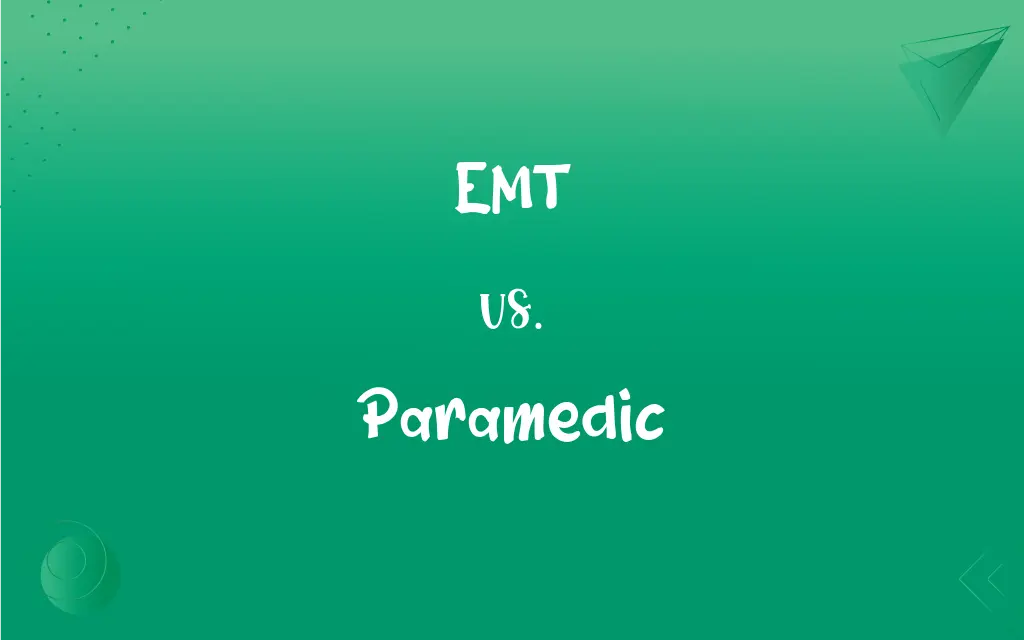EMT vs. Paramedic: What's the Difference?
Edited by Aimie Carlson || By Janet White || Published on March 12, 2024
EMTs provide basic emergency medical care and transportation, while Paramedics offer advanced care, including administering drugs and interpreting EKGs.

Key Differences
Emergency Medical Technicians (EMTs) and Paramedics are both crucial providers of pre-hospital emergency care, but they differ significantly in their level of training and the scope of practice. EMTs undergo a course that covers basic life support skills such as CPR, oxygen administration, and assisting with certain medications. Paramedics, on the other hand, receive more extensive training that includes advanced life support (ALS) techniques, such as administering a wider range of medications, performing endotracheal intubation, and interpreting electrocardiograms (EKGs).
The education required to become an EMT is typically less than that required for a Paramedic. EMT programs can often be completed in a few months, whereas Paramedic training can take one to two years, involving both in-depth classroom education and clinical experience. This additional training equips Paramedics with a deeper understanding of medical procedures and patient care.
In terms of responsibilities, EMTs are trained to perform a variety of pre-hospital care functions but are limited to basic emergency care and transportation to medical facilities. Paramedics have a broader scope of practice, including performing advanced medical procedures and making more autonomous decisions about patient care in emergency situations.
The decision to pursue a career as an EMT or Paramedic depends on one's commitment to education, career goals, and interest in providing medical care. EMTs can serve as a stepping stone to becoming a Paramedic, offering a foundational understanding of emergency medical services (EMS) and patient care.
Both EMTs and Paramedics play integral roles in the EMS system, working closely together to provide emergency medical services to the community. While their levels of training and responsibilities differ, their primary goal is the same: to offer immediate care and transportation for the sick and injured, ultimately saving lives.
ADVERTISEMENT
Comparison Chart
Training Level
Basic life support (BLS)
Advanced life support (ALS)
Education Length
Shorter (months)
Longer (1-2 years)
Scope of Practice
Basic emergency care
Advanced medical procedures
Responsibilities
Transport, basic medical care
Comprehensive pre-hospital medical care
Skills
CPR, oxygen administration, splinting
Administering medications, intubation, EKG interpretation
ADVERTISEMENT
Autonomy
Limited decision-making
Higher level of decision-making
Medication Administration
Limited to certain conditions
Broad range of medications
Procedures
Basic procedures
Complex procedures and life support
Career Path
Entry-level into emergency medical services
Requires further education and training
Clinical Experience
Less required
Extensive required
EMT and Paramedic Definitions
EMT
Responds to emergency calls to offer immediate care.
EMTs arrived and administered first aid to the injured cyclist.
Paramedic
Engages in complex medical procedures in the field.
The Paramedic interpreted the EKG and recognized signs of a heart attack.
EMT
A professional trained to provide basic emergency medical services.
The EMT quickly assessed the patient's condition at the scene.
Paramedic
A healthcare professional with advanced training in emergency medical services.
The Paramedic administered life-saving medication en route to the hospital.
EMT
Key role in the emergency medical services system.
EMTs transported the heart attack victim to the hospital promptly.
Paramedic
Performs comprehensive pre-hospital care.
Paramedics performed an emergency intubation to secure the patient's airway.
EMT
Requires certification and ongoing education.
The EMT attended a workshop to update his CPR skills.
Paramedic
Has authority to administer a wide range of medications.
The Paramedic used his training to select the appropriate drug for a patient in shock.
EMT
Operates within a defined scope of practice.
The EMT applied a splint to stabilize the broken leg.
Paramedic
Continuously updates knowledge and skills.
The Paramedic completed advanced cardiac life support certification.
Paramedic
A person who is trained to give emergency medical treatment or assist medical professionals.
Paramedic
An individual trained to medically stabilize people through various interventions, victims of trauma or medical events outside of a hospital setting and preparing them for transport to a medical facility.
Paramedic
(US) An individual who is licensed at the state or national level to practice medical interventions in an emergency pre-hospital setting.
Paramedic
A person trained to assist medical professionals and to give emergency medical treatment
FAQs
Can an EMT administer medications?
EMTs can administer a limited number of medications under specific conditions.
What advanced procedures can Paramedics perform?
Paramedics can perform advanced procedures such as intubation, administering IV medications, and interpreting EKGs.
Is clinical experience required for EMT and Paramedic training?
Yes, both require clinical experience, but Paramedic training involves more extensive clinical rotations.
How long does Paramedic training take?
Paramedic training usually requires one to two years of education, including classroom instruction and clinical experience.
What is the difference in scope of practice between EMTs and Paramedics?
EMTs provide basic life support, while Paramedics are trained for advanced life support, including more complex medical interventions.
What role does an EMT play in the emergency medical services system?
EMTs are first responders who provide initial care and transportation for patients in emergency situations.
Are Paramedics able to make more autonomous decisions than EMTs?
Yes, Paramedics have a higher level of training that allows for more autonomous decision-making in patient care.
How does the responsibility of a Paramedic differ from that of an EMT?
Paramedics have more comprehensive responsibilities, including performing advanced medical procedures and managing complex emergency scenes.
What certifications are required to practice as a Paramedic?
Paramedics must complete a state-approved Paramedic program and pass a national certification exam.
Can EMTs become Paramedics?
Yes, EMTs can advance to become Paramedics through additional education and training.
How do EMT and Paramedic roles complement each other in emergencies?
EMTs and Paramedics work together in a tiered response, providing a range of medical care from basic to advanced levels.
What education is required to become an EMT?
EMT certification requires completion of a state-approved training program, typically lasting a few months.
What are the career advancement opportunities for EMTs and Paramedics?
Both can pursue further education and specialization, leadership roles, or transition to other healthcare professions.
Can EMTs and Paramedics administer CPR?
Yes, both are trained to administer CPR as part of their lifesaving skills.
How does the pay differ between EMTs and Paramedics?
Paramedics typically earn higher salaries than EMTs due to their advanced training and scope of practice.
Is ongoing education important for both EMTs and Paramedics?
Yes, both professions require ongoing education to maintain certification and stay updated on best practices.
How important is physical fitness for EMTs and Paramedics?
Physical fitness is crucial for both, as they often need to lift patients and equipment and perform in high-stress situations.
Can Paramedics work in settings other than ambulances?
Yes, Paramedics can work in various settings, including hospitals, fire departments, and as part of air medical teams.
Are there different levels of EMT certification?
Yes, there are several levels, including EMT-Basic, EMT-Intermediate, and Paramedic, with increasing levels of responsibility.
What is the biggest challenge faced by EMTs and Paramedics?
One of the biggest challenges is operating in high-pressure situations, requiring quick decision-making and precise medical intervention.
About Author
Written by
Janet WhiteJanet White has been an esteemed writer and blogger for Difference Wiki. Holding a Master's degree in Science and Medical Journalism from the prestigious Boston University, she has consistently demonstrated her expertise and passion for her field. When she's not immersed in her work, Janet relishes her time exercising, delving into a good book, and cherishing moments with friends and family.
Edited by
Aimie CarlsonAimie Carlson, holding a master's degree in English literature, is a fervent English language enthusiast. She lends her writing talents to Difference Wiki, a prominent website that specializes in comparisons, offering readers insightful analyses that both captivate and inform.































































